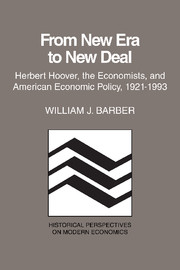Book contents
- Frontmatter
- Contents
- Preface
- Prologue: The vision of a new era in the 1920s
- 1 The ingredients of a model of a new economics
- 2 Challenges to the new economics of the 1920s
- 3 The new economics at center stage in 1929
- 4 Activating the stabilization model in late 1929 and 1930
- 5 Preliminary readings of the results of the stabilization strategy
- 6 The unraveling of the first official model in 1931
- 7 Shifting course in late 1931 and early 1932
- 8 Renewing the offensive in February and March 1932
- 9 The economists and their views on policy for 1932
- 10 Official model II as shaped in May 1932 and the aftermath
- Epilogue: Transition to the New Deal – continuities and discontinuities
- Notes
- Selected bibliography
- Index
10 - Official model II as shaped in May 1932 and the aftermath
Published online by Cambridge University Press: 19 October 2009
- Frontmatter
- Contents
- Preface
- Prologue: The vision of a new era in the 1920s
- 1 The ingredients of a model of a new economics
- 2 Challenges to the new economics of the 1920s
- 3 The new economics at center stage in 1929
- 4 Activating the stabilization model in late 1929 and 1930
- 5 Preliminary readings of the results of the stabilization strategy
- 6 The unraveling of the first official model in 1931
- 7 Shifting course in late 1931 and early 1932
- 8 Renewing the offensive in February and March 1932
- 9 The economists and their views on policy for 1932
- 10 Official model II as shaped in May 1932 and the aftermath
- Epilogue: Transition to the New Deal – continuities and discontinuities
- Notes
- Selected bibliography
- Index
Summary
Though debates among the academic economists would continue to rage about the proper interpretation of events and about appropriate courses for economic policy, Hoover could not wait until the professionals resolved their differences before deciding on next steps. By May 1932 it was clear that the attack on the liquidity trap begun in February had failed. Hoarding had begun again, the rate of bank failures – which for a time had been slowed – accelerated, and the gold outflow had resumed.
These setbacks notwithstanding, the experience of the preceding months had still taught some lessons. In the first place, it had exposed the fragility of the banking structure even more clearly, and this seemed to underscore further the importance of a fiscal policy designed to support bond values. Second, it had demonstrated that banks could not be relied upon to stimulate the flow of credit, even when their capacity to do so had been considerably augmented. This finding suggested that other measures would be needed to reactivate lending and spending. Third, the disappointing performance of the economy meant that the administration's hopes that the momentum of recovery would be well underway by the early autumn were unlikely to be fulfilled. In view of that prospect, a rethinking of the federal government's role in the provision of relief appeared to be in order.
Even though the strategy adopted at the beginning of the year had not achieved its objective, Hoover was determined to regain the initiative. He could agree with part of the diagnosis of the situation then offered by Keynes.
- Type
- Chapter
- Information
- From New Era to New DealHerbert Hoover, the Economists, and American Economic Policy, 1921–1933, pp. 169 - 188Publisher: Cambridge University PressPrint publication year: 1985

